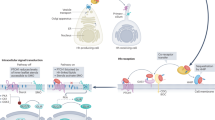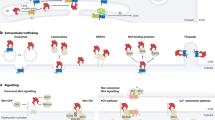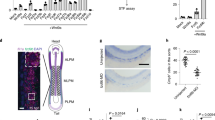Abstract
Wnt signalling is involved in numerous events in animal development1, including the proliferation of stem cells2 and the specification of the neural crest3. Wnt proteins are potentially important reagents in expanding specific cell types, but in contrast to other developmental signalling molecules such as hedgehog proteins and the bone morphogenetic proteins, Wnt proteins have never been isolated in an active form. Although Wnt proteins are secreted from cells4,5,6,7, secretion is usually inefficient8 and previous attempts to characterize Wnt proteins have been hampered by their high degree of insolubility. Here we have isolated active Wnt molecules, including the product of the mouse Wnt3a gene. By mass spectrometry, we found the proteins to be palmitoylated on a conserved cysteine. Enzymatic removal of the palmitate or site-directed and natural mutations of the modified cysteine result in loss of activity, and indicate that the lipid is important for signalling. The purified Wnt3a protein induces self-renewal of haematopoietic stem cells, signifying its potential use in tissue engineering.
This is a preview of subscription content, access via your institution
Access options
Subscribe to this journal
Receive 51 print issues and online access
$199.00 per year
only $3.90 per issue
Buy this article
- Purchase on Springer Link
- Instant access to full article PDF
Prices may be subject to local taxes which are calculated during checkout



Similar content being viewed by others
References
Cadigan, K. & Nusse, R. Wnt signaling: a common theme in animal development. Genes Dev. 11, 3286–3305 (1997)
van de Wetering, M. et al. The beta-catenin/TCF-4 complex imposes a crypt progenitor phenotype on colorectal cancer cells. Cell 111, 241–250 (2002)
Garcia-Castro, M. I., Marcelle, C. & Bronner-Fraser, M. Ectodermal Wnt function as a neural crest inducer. Science 297, 848–851 (2002)
Papkoff, J. & Schryver, B. Secreted int-1 protein is associated with the cell surface. Mol. Cell Biol. 10, 2723–2730 (1990)
Van Leeuwen, F., Harryman Samos, C. H. & Nusse, R. Biological activity of soluble wingless protein in cultured Drosophila imaginal disc cells. Nature 368, 342–344 (1994)
Burrus, L. W. & McMahon, A. P. Biochemical analysis of murine Wnt proteins reveals both shared and distinct properties. Exp. Cell Res. 220, 363–373 (1995)
Hsieh, J. C., Rattner, A., Smallwood, P. M. & Nathans, J. Biochemical characterization of Wnt-frizzled interactions using a soluble, biologically active vertebrate Wnt protein. Proc. Natl Acad. Sci. USA 96, 3546–3551 (1999)
Bradley, R. S. & Brown, A. M. A soluble form of Wnt-1 protein with mitogenic activity on mammary epithelial cells. Mol. Cell Biol. 15, 4616–4622 (1995)
Roelink, H. & Nusse, R. Expression of two members of the Wnt gene family during mouse development; restricted temporal and spatial patterns in the developing neural tube. Genes Dev. 5, 381–388 (1991)
Polakis, P. Wnt signaling and cancer. Genes Dev. 14, 1837–1851 (2000)
Shibamoto, S. et al. Cytoskeletal reorganization by soluble Wnt-3a protein signalling. Genes Cells 3, 659–670 (1998)
Brannon, M. & Kimelman, D. Activation of Siamois by the Wnt pathway. Dev. Biol. 180, 344–347 (1996)
McKendry, R., Hsu, S. C., Harland, R. M. & Grosschedl, R. LEF-1/TCF proteins mediate wnt-inducible transcription from the Xenopus nodal-related 3 promoter. Dev. Biol. 192, 420–431 (1997)
Bordier, C. Phase separation of integral membrane proteins in Triton X-114 solution. J. Biol. Chem. 256, 1604–1607 (1981)
Duncan, J. A. & Gilman, A. G. A cytoplasmic acyl-protein thioesterase that removes palmitate from G protein alpha subunits and p21(RAS). J. Biol. Chem. 273, 15830–15837 (1998)
Mason, J. O., Kitajewski, J. & Varmus, H. E. Mutational analysis of mouse Wnt-1 identifies two temperature-sensitive alleles and attributes of Wnt-1 protein essential for transformation of a mammary cell line. Mol. Biol. Cell 3, 521–533 (1992)
Maloof, J. N., Whangbo, J., Harris, J. M., Jongeward, G. D. & Kenyon, C. A Wnt signalling pathway controls hox gene expression and neuroblast migration in C. elegans. Development 126, 37–49 (1999)
Couso, J. P. & Arias, A. M. Notch is required for wingless signaling in the epidermis of Drosophila. Cell 79, 259–272 (1994)
Reya, T. et al. A role for Wnt signalling in self-renewal of haematopoietic stem cells. Nature advance online publication, 27 April 2003 (doi:10.1038/nature01593)
Kadowaki, T., Wilder, E., Klingensmith, J., Zachary, K. & Perrimon, N. The segment polarity gene porcupine encodes a putative multitransmembrane protein involved in Wingless processing. Genes Dev. 10, 3116–3128 (1996)
Rocheleau, C. E. et al. Wnt signaling and an APC-related gene specify endoderm in early C. elegans embryos. Cell 90, 707–716 (1997)
Hofmann, K. A superfamily of membrane-bound O-acyltransferases with implications for wnt signaling. Trends Biochem. Sci. 25, 111–112 (2000)
Tanaka, K., Kitagawa, Y. & Kadowaki, T. Drosophila segment polarity gene product porcupine stimulates the posttranslational N-glycosylation of wingless in the endoplasmic reticulum. J. Biol. Chem. 277, 12816–12823 (2002)
Noordermeer, J., Klingensmith, J., Perrimon, N. & Nusse, R. dishevelled and armadillo act in the wingless signalling pathway in Drosophila. Nature 367, 80–83 (1994)
Pepinsky, R. B. et al. Identification of a palmitic acid-modified form of human Sonic hedgehog. J. Biol. Chem. 273, 14037–14045 (1998)
Wu, C. H. & Nusse, R. Ligand receptor interactions in the WNT signaling pathway in Drosophila. J. Biol. Chem. 277, 41762–41769 (2002)
MacCoss, M. J. et al. Shotgun identification of protein modifications from protein complexes and lens tissue. Proc. Natl Acad. Sci. USA 99, 7900–7905 (2002)
Washburn, M. P., Wolters, D. & Yates, J. R. Large-scale analysis of the yeast proteome by multidimensional protein identification technology. Nature Biotechnol. 19, 242–247 (2001)
Tabb, D., McDonald, W. H. & Yates, J. R. DTASelect and Contrast: tools for assembling and comparing protein identifications from shotgun proteomics. J. Proteome Res. 1, 21–26 (2002)
Domen, J. & Weissman, I. L. Hematopoietic stem cells need two signals to prevent apoptosis; BCL-2 can provide one of these, Kit1/c-Kit signaling the other. J. Exp. Med. 192, 1707–1718 (2000)
Acknowledgements
We are grateful to C.-h. Wu for generating the S2 cells expressing Drosophila Wnt8; M. Silverman for help in the C57MG cell transformation assay; and S. Anderson for advice on mass spectrometry. Xenopus embryos were provided by J. Baker and A. Borchers. A. Gilman provided APT-1, and A. Martinez-Arias the wgS21 stock. J. Nelson and members of our laboratories provided comments on the manuscript. This work was supported by Howard Hughes Medical Institute and a NIH grant awarded to T.R. R.N. is an investigator of the Howard Hughes Medical Institute.
Author information
Authors and Affiliations
Corresponding author
Ethics declarations
Competing interests
The authors declare that they have no competing financial interests.
Supplementary information
Rights and permissions
About this article
Cite this article
Willert, K., Brown, J., Danenberg, E. et al. Wnt proteins are lipid-modified and can act as stem cell growth factors. Nature 423, 448–452 (2003). https://doi.org/10.1038/nature01611
Received:
Accepted:
Published:
Issue Date:
DOI: https://doi.org/10.1038/nature01611
This article is cited by
-
WNT Signaling in Stem Cells: A Look into the Non-Canonical Pathway
Stem Cell Reviews and Reports (2024)
-
How ceramides affect the development of colon cancer: from normal colon to carcinoma
Pflügers Archiv - European Journal of Physiology (2024)
-
PRMT2 promotes RCC tumorigenesis and metastasis via enhancing WNT5A transcriptional expression
Cell Death & Disease (2023)
-
CDK5RAP2 is a Wnt target gene and promotes stemness and progression of oral squamous cell carcinoma
Cell Death & Disease (2023)
-
ACSL5, a prognostic factor in acute myeloid leukemia, modulates the activity of Wnt/β-catenin signaling by palmitoylation modification
Frontiers of Medicine (2023)
Comments
By submitting a comment you agree to abide by our Terms and Community Guidelines. If you find something abusive or that does not comply with our terms or guidelines please flag it as inappropriate.



